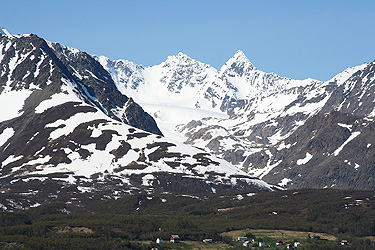Store Lenangstind
- Store Lenangstind
- 1624 m
- Primary factor 1576 m
- Location: North 69:42.605, East 020:05.156, (GPS on the summit)
- In Lyngen, Troms, Norway
- Good try (did not summit) August 2, 2005. Reached about N69:42.640, E020:05.477.
- Climbed: June 1, 2007.
- Difficulty: Alpine PD, steep snow to 50 degrees, crevasses, YDS class 4 (August 05).
- Difficulty: Alpine AD, steep snow to 50 degrees, YDS class 5 (winter climb, June 07).
